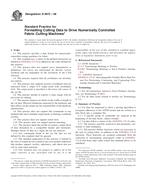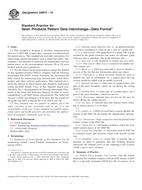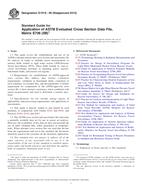We need your consent to use the individual data so that you can see information about your interests, among other things. Click "OK" to give your consent.
ASTM D6672-08
Standard Practice for Formatting Cutting Data to Drive Numerically Controlled Fabric Cutting Machines (Withdrawn 2017)
Automatically translated name:
Standard Practice for Formatting Cutting Data to Drive Numerically Controlled Fabric Cutting Machines
STANDARD published on 1.7.2008
The information about the standard:
Designation standards: ASTM D6672-08
Note: WITHDRAWN
Publication date standards: 1.7.2008
SKU: NS-36100
The number of pages: 4
Approximate weight : 12 g (0.03 lbs)
Country: American technical standard
Category: Technical standards ASTM
The category - similar standards:
IT applications in industryProcesses of the textile industry
Annotation of standard text ASTM D6672-08 :
Keywords:
apparel, cut file, cutter, marker, sewn goods, sewn product, upholstery, vector data, Cutting data, Data analysis--textiles, Fabric performance--textiles, Formatting data, Numerically-controlled fabric cutting machines, Performance--textiles, ICS Number Code 35.240.50 (IT applications in industry), 59.020 (Processes of the textile industry)
Additional information
| Significance and Use | ||||||
|
This practice provides a common format that allows a computer design system to generate data that an output device can accurately reproduce independent of the hardware manufacturer. |
||||||
| 1. Scope | ||||||
|
1.1 This practice specifies a data format for numerically-controlled cutting machines for fabric. 1.2 This standard uses a subset of the defined instruction set defined in ANSI/EIA-274-D in addition to the codes defined by this practice. 1.3 This practice does not support curve interpolation or definitions. All curves are represented by discrete vectors (stroked) and are dependent on the resolution of the CAD software. 1.4 This practice requires that all coordinates are absolute, not relative. 1.5 This practice only supports positive coordinates that are measured from a single X-Y origin point with coordinates (0,0). The origin point is specified as the lower left corner of the cut file. 1.6 This practice intends to transfer a static image with no provision for editing. 1.7 This practice imposes no limits on the width or length of the cut data. Physical limitations imposed by the hardware and their effects on the output are the responsibility of the hardware manufacturer. 1.8 This practice does not support bite commands or any methods that insert multiple origin points or floating coordinate systems. 1.9 This practice does not support notch tools. 1.10 This practice does not support pattern matching. 1.11 This practice limits the cut file to contain a single block of data demarked by a compatible header and terminator. Multiple blocks of data in a single file are not allowed. 1.12 Any commands found in the cut file that are not defined by this standard shall be ignored. 1.13 The intended application of this practice is limited to the class of output devices found in the sewn product industries that produce apparel, textiles, upholstery, and others that use soft or semi-rigid materials. 1.14 This standard does not purport to address all of the safety concerns, if any, associated with its use. It is the responsibility of the user of this standard to establish appropriate safety and health practices and determine the applicability of regulatory limitations prior to use. |
||||||
| 2. Referenced Documents | ||||||
|
Similar standards:
Historical
1.5.2012
Historical
1.5.2012
Historical
1.5.2012
Historical
1.1.2010
Historical
1.6.2013
Historical
1.5.2013
We recommend:
Updating of laws
Do you want to be sure about the validity of used regulations?
We offer you a solution so that you could use valid and updated legislative regulations.
Would you like to get more information? Look at this page.



 ASTM D380-94(2012)..
ASTM D380-94(2012).. ASTM D3902-90(2012)..
ASTM D3902-90(2012).. ASTM D622-99(2012)..
ASTM D622-99(2012).. ASTM D6673-10
ASTM D6673-10 ASTM E1018-09(2013)..
ASTM E1018-09(2013).. ASTM E1434-00(2013)..
ASTM E1434-00(2013)..
 Cookies
Cookies
